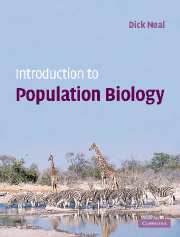Book contents
- Frontmatter
- Contents
- Preface
- Acknowledgements
- PART I Evolution by natural selection
- PART II Simple population growth models and their simulation
- PART III Population genetics and evolution
- Chapter 6 Gene frequencies and the Hardy–Weinberg principle
- Chapter 7 Mutation and the genetic variation of populations
- Chapter 8 Small populations, genetic drift and inbreeding
- Chapter 9 Migration, gene flow and the differentiation of populations
- Chapter 10 Quantifying natural selection: haploid and zygotic selection models
- Chapter 11 Applying zygotic selection models to natural systems
- Chapter 12 Polygenic inheritance, quantitative genetics and heritability
- Chapter 13 Population genetics: summary and synthesis
- PART IV Demography
- PART V Interactions between species, and the behaviour of individuals
- Glossary
- Solutions to problems
- References
- Index
Chapter 6 - Gene frequencies and the Hardy–Weinberg principle
- Frontmatter
- Contents
- Preface
- Acknowledgements
- PART I Evolution by natural selection
- PART II Simple population growth models and their simulation
- PART III Population genetics and evolution
- Chapter 6 Gene frequencies and the Hardy–Weinberg principle
- Chapter 7 Mutation and the genetic variation of populations
- Chapter 8 Small populations, genetic drift and inbreeding
- Chapter 9 Migration, gene flow and the differentiation of populations
- Chapter 10 Quantifying natural selection: haploid and zygotic selection models
- Chapter 11 Applying zygotic selection models to natural systems
- Chapter 12 Polygenic inheritance, quantitative genetics and heritability
- Chapter 13 Population genetics: summary and synthesis
- PART IV Demography
- PART V Interactions between species, and the behaviour of individuals
- Glossary
- Solutions to problems
- References
- Index
Summary
Population genetics considers how the frequencies of alternative states of genes in populations are maintained or changed from generation to generation. First, however, it is important that we understand the terms that are used; otherwise, it is easy for beginners to become confused. It is also important to know how the terms will be used in this book, because many of the terms are not used consistently in the wider literature.
Terminology
The following should clarify how the various terms introduced in this chapter are used throughout the book.
phenotype The morphological, physiological, behavioural or biochemical characteristic of an individual, or a group of individuals in a population. Typically, the term refers to a single characteristic, such as body colour or blood group type, but can also refer to more than one characteristic. Almost invariably, there is more than one phenotype for a given characteristic. For example, there may be both short and tall plants in a population.
genotype This is the genetic constitution of an individual, or a group of individuals in a population, which is related by simple Mendelian rules to the phenotype. The theory in this book mainly considers genes with just two different alleles in the population, e.g. A and B, so that there will be just three different genotypes, AA, AB and BB. These will result in three different phenotypes if there is no dominance, but only two if there is dominance. If genotypes AA and AB give rise to the same phenotype, A is considered to be dominant to B, and if AB and BB give the same phenotype, B is considered dominant to A. Theory relating to multiple genes and alleles is considered in Chapter 12.
- Type
- Chapter
- Information
- Introduction to Population Biology , pp. 87 - 99Publisher: Cambridge University PressPrint publication year: 2003



